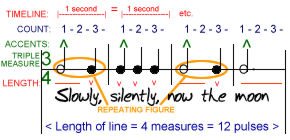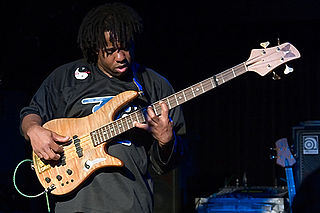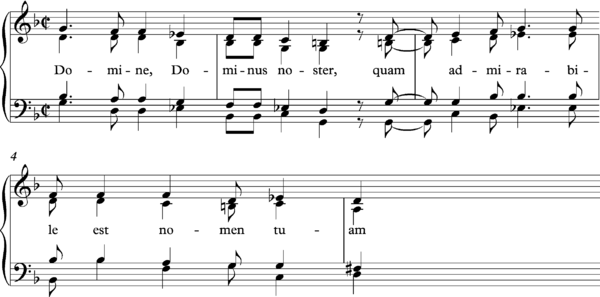
In music, counterpoint is the relationship between two or more musical lines which are harmonically interdependent yet independent in rhythm and melodic contour. It has been most commonly identified in the European classical tradition, strongly developing during the Renaissance and in much of the common practice period, especially in the Baroque period. The term originates from the Latin punctus contra punctum meaning "point against point", i.e. "note against note".
Rhythm generally means a "movement marked by the regulated succession of strong and weak elements, or of opposite or different conditions". This general meaning of regular recurrence or pattern in time can apply to a wide variety of cyclical natural phenomena having a periodicity or frequency of anything from microseconds to several seconds ; to several minutes or hours, or, at the most extreme, even over many years.

In music, metre or meter refers to regularly recurring patterns and accents such as bars and beats. Unlike rhythm, metric onsets are not necessarily sounded, but are nevertheless implied by the performer and expected by the listener.

Polyrhythm is the simultaneous use of two or more rhythms that are not readily perceived as deriving from one another, or as simple manifestations of the same meter. The rhythmic layers may be the basis of an entire piece of music (cross-rhythm), or a momentary section. Polyrhythms can be distinguished from irrational rhythms, which can occur within the context of a single part; polyrhythms require at least two rhythms to be played concurrently, one of which is typically an irrational rhythm. Concurrently in this context means within the same rhythmic cycle. The underlying pulse, whether explicit or implicit can be considered one of the concurrent rhythms. For example, the son clave is poly-rhythmic because its 3 section suggests a different meter from the pulse of the entire pattern.
In music, hemiola is the ratio 3:2. The equivalent Latin term is sesquialtera. In rhythm, hemiola refers to three beats of equal value in the time normally occupied by two beats. In pitch, hemiola refers to the interval of a perfect fifth.
In music, an ostinato is a motif or phrase that persistently repeats in the same musical voice, frequently in the same pitch. Well-known ostinato-based pieces include classical compositions such as Ravel's Boléro and the Carol of the Bells, and popular songs such as Donna Summer and Giorgio Moroder's "I Feel Love" (1977), Henry Mancini's theme from Peter Gunn (1959), The Who's "Baba O'Riley" (1971), and The Verve's "Bitter Sweet Symphony" (1997).

Bassline is the term used in many styles of music, such as blues, jazz, funk, dub and electronic, traditional, and classical music, for the low-pitched instrumental part or line played by a rhythm section instrument such as the electric bass, double bass, cello, tuba or keyboard.

In music and music theory, the beat is the basic unit of time, the pulse, of the mensural level. The beat is often defined as the rhythm listeners would tap their toes to when listening to a piece of music, or the numbers a musician counts while performing, though in practice this may be technically incorrect. In popular use, beat can refer to a variety of related concepts, including pulse, tempo, meter, specific rhythms, and groove.
In musical notation, a bar is a segment of music bounded by vertical lines, known as bar lines, usually indicating one of more recurring beats. The length of the bar, measured by the number of note values it contains, is normally indicated by the time signature.
In Western musical theory, a cadence is the end of a phrase in which the melody or harmony creates a sense of full or partial resolution, especially in music of the 16th century onwards. A harmonic cadence is a progression of two or more chords that concludes a phrase, section, or piece of music. A rhythmic cadence is a characteristic rhythmic pattern that indicates the end of a phrase. A cadence can be labeled "weak" or "strong" depending on the impression of finality it gives. While cadences are usually classified by specific chord or melodic progressions, the use of such progressions does not necessarily constitute a cadence—there must be a sense of closure, as at the end of a phrase. Harmonic rhythm plays an important part in determining where a cadence occurs. The word "cadence" sometimes slightly shifts its meaning depending on the context; for example, it can be used to refer to the last few notes of a particular phrase, or to just the final chord of that phrase, or to types of chord progressions that are suitable for phrase endings in general.
In music, variation is a formal technique where material is repeated in an altered form. The changes may involve melody, rhythm, harmony, counterpoint, timbre, orchestration or any combination of these.
In music, an accent is an emphasis, stress, or stronger attack placed on a particular note or set of notes, or chord, either as a result of its context or specifically indicated by an accent mark. Accents contribute to the articulation and prosody of a performance of a musical phrase. Accents may be written into a score or part by a composer, or added by the performer as part of their interpretation of a musical piece.

In music, the term period refers to certain types of recurrence in small-scale formal structure. In twentieth-century music scholarship, the term is usually used as defined by the Oxford Companion to Music: "a period consists of two phrases, antecedent and consequent, each of which begins with the same basic motif." Earlier usage varied somewhat, but usually referred to similar notions of symmetry, recurrence, and closure. The concept of a musical period originates in comparisons between music structure and rhetoric at least as early as the 16th century.

The Variations and Fugue on a Theme by Handel, Op. 24, is a work for solo piano written by Johannes Brahms in 1861. It consists of a set of twenty-five variations and a concluding fugue, all based on a theme from George Frideric Handel's Harpsichord Suite No. 1 in B♭ major, HWV 434. They are known as his Handel Variations.
A cinquillo is a typical Cuban/Caribbean rhythmic cell, used in the Cuban contradanza and the danzón. The figure is also a common bell pattern found throughout sub-Saharan Africa. It consists of an eighth, a sixteenth, an eighth, a sixteenth, and an eighth note. Placing this rhythm in a 2/4 measure produces a strongly syncopated character from the sustained note which replaces an articulated one on the first quarter of the second beat. Cinquillo is an embellishment of the more basic pattern known as tresillo. Cinquillo is shown twice below. The first one merely displays the note values. The second one is a so-called orthographic notation, which gives an impression of the syncopated character.

In popular music, half-time is a type of meter and tempo that alters the rhythmic feel by essentially doubling the tempo resolution or metric division/level in comparison to common-time. Thus, two measures of 4
4 approximate a single measure of 8
8, while a single measure of 4/4 emulates 2/2. Half-time is not to be confused with alla breve or odd time. Though notes usually get the same value relative to the tempo, the way the beats are divided is altered. While much music typically has a backbeat on quarter note (crotchet) beats two and four, half time would increase the interval between backbeats to double, thus making it hit on beats three and seven, or the third beat of each measure :
1 2 3 4 1 2 3 4 1 2 3 4 5 6 7 8 1 2 3 4
Excursions, Op. 20, is the first published solo piano piece by Samuel Barber. Barber himself explains:
These are ‘Excursions’ in small classical forms into regional American idioms. Their rhythmic characteristics, as well as their source in folk material and their scoring, reminiscent of local instruments are easily recognized.
In music, a cross-beat or cross-rhythm is a specific form of polyrhythm. The term cross rhythm was introduced in 1934 by the musicologist Arthur Morris Jones (1889–1980). It refers to a situation where the rhythmic conflict found in polyrhythms is the basis of an entire musical piece.
Michael Tippett's Concerto for Double String Orchestra (1938–39) is one of his most popular and frequently performed works.
Tresillo is a rhythmic pattern used in Latin American music. It is a more basic form of the rhythmic figure known as the habanera.





















